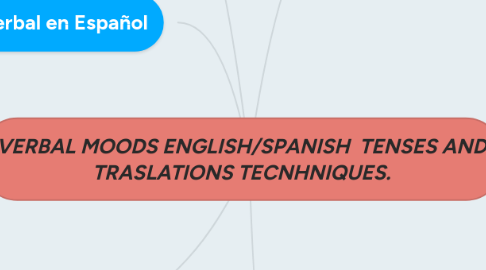
1. Tense in English
1.1. A verb-based method used to indicate the time, and sometimes the continuation or completeness, of an action or state in relation to the time of speaking.
1.1.1. Time: Is a concept which is related to our perception of reality.
1.1.2. Aspect: Is a grammatical category that expresses how an action, event, or state, denoted by a verb, extends over time.
2. Moods in English
2.1. Also called mode, in grammar, a category that reflects the speaker’s view of the ontological characterof an event
2.1.1. Indicative Moods: Indicating a state of factuality and reality.
2.1.2. Subjunctive mood: Indicating hypothetical state, a state contrary to reality, such as a wish, a desire, or an imaginary situation.
2.1.3. Imperative Mood: Indicating a state of command.
2.1.4. Interrogative Moods: Indicating a state of questioning.
3. Tiempo verbal en Español
3.1. Llamamos tiempos al conjunto de formas verbales que presentan la acción de la misma manera y corresponden a un mismo tiempo (pasado, presente o futuro).
3.1.1. PRESENTE: El verbo expresa acciones que se están realizando ahora mismo según la expresión del hablante (aunque en realidad puede que no se estén dando ahora).
3.1.2. PASADO: El verbo expresa acciones que ya han pasado.
3.1.3. FUTURO: El verbo expresa acciones que aún no han pasado
4. Translation Techniques
4.1. Direct traslation (literal/word-for-word)
4.1.1. Transposition: Is the first technique or step towards oblique translation.
4.1.2. Borring: Is the idea of taking the word from the source language (SL) and maintaining it in the target language (TL).
4.1.3. Calque: Is when an expression from the source text (ST) is transferred literally into the TT.
4.1.4. Lieral translation: Is only to be used under certain circumstances according to Vinay and Darbelnet.
4.2. Oblique Translation (free)
4.2.1. Modulation: A variation of the form of the message obtained by a change in the point of view.
4.2.2. Equivalence: Used to render expressions using different stylistic and structural methods.
4.2.3. Adaptation: Used when the limit to translation is been reached, i.e. when a simple translation would not work or it would produce a result that is shocking in the target language and culture.
4.2.4. Amplification: Development that is given in writing or in words to a proposition or idea, explaining it in various ways or listing points or circumstances that are related to it, in order to make it more effective in moving or persuading.
4.2.5. Omission: It consists of omitting words.
5. Tipos de modos verbales en Español
5.1. Son las diversas formas en que la acción del verbo puede expresarse. hay tres modos verbales: indicativo, subjuntivo e imperativo
5.1.1. El modo indicativo: El modo indicativo del verbo se caracteriza por expresar acciones concretas y reales.
5.1.2. Modo Imperativo: Los verbos conjugados en el modo imperativo sirven para expresar alguna orden, para advertir, amenazar o rogar
5.1.3. Modo subjuntivo: El modo subjuntivo del verbo expresa una posibilidad, una acción hipotética.
5.1.4. El modo condicional /modo potencial: porque en ocasiones se refiere a acciones hipotéticas o posibles
